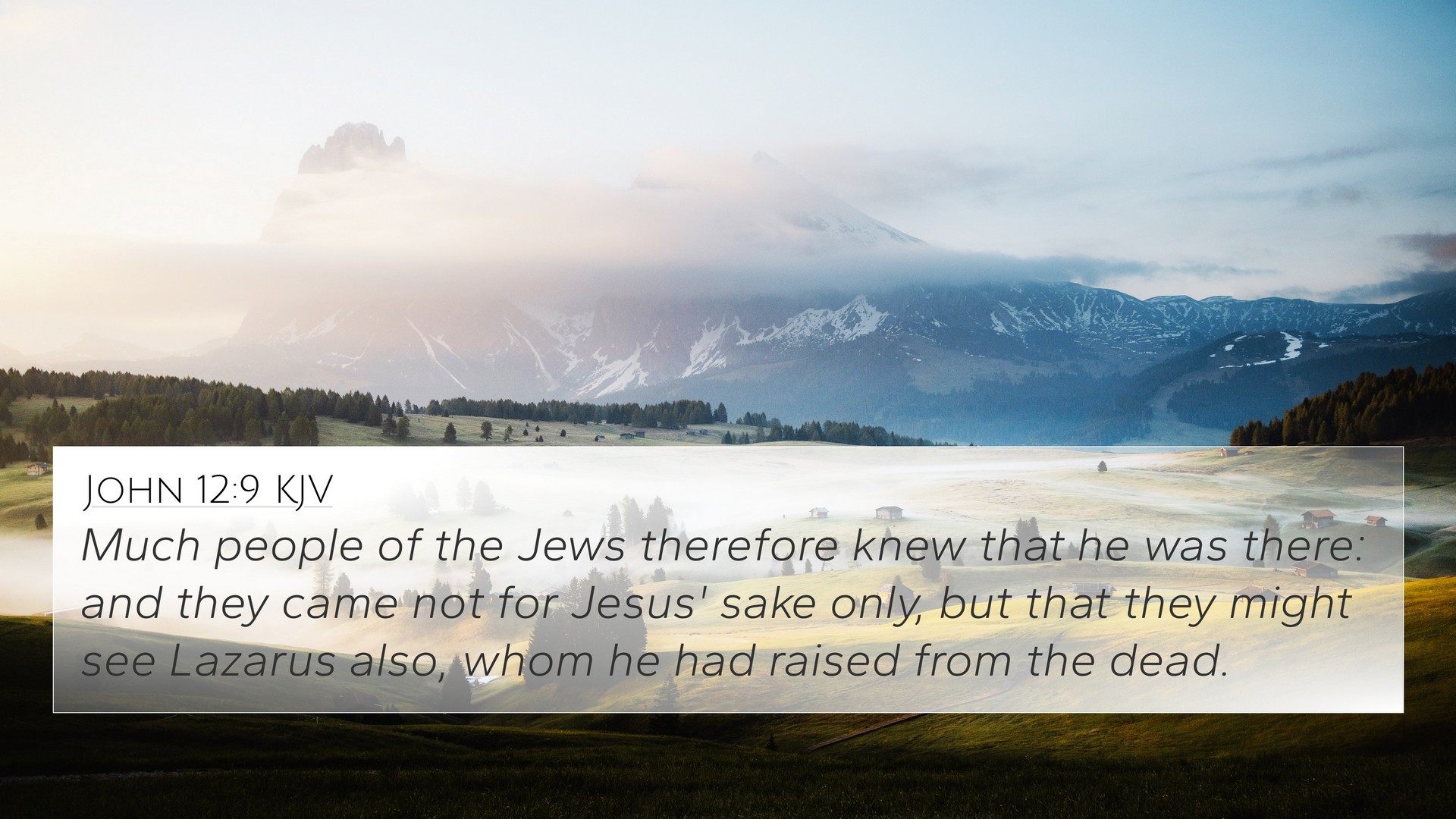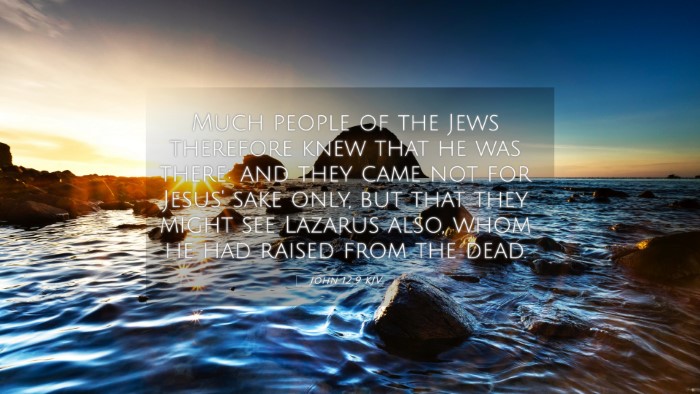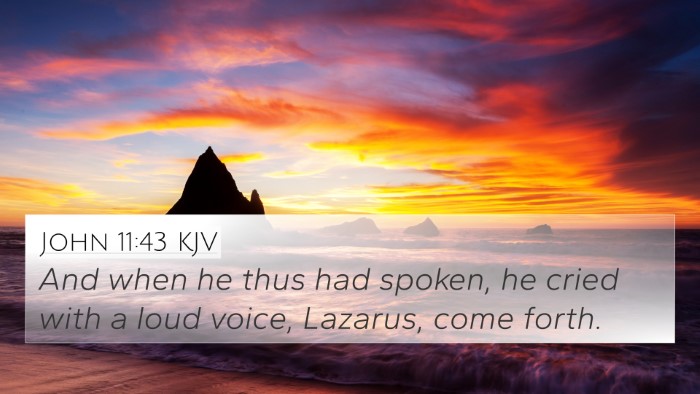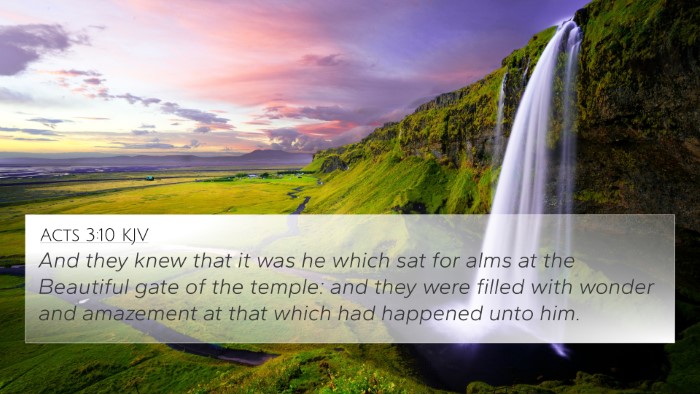Understanding John 12:9
John 12:9 states: "Meanwhile a large crowd of Jews found out that Jesus was there and came, not only because of him but also to see Lazarus, whom he had raised from the dead."
This verse holds significant meaning as it captures a pivotal moment in Jesus’ ministry, showcasing the impact of His miraculous acts, specifically the raising of Lazarus. Below is a combined insight derived from various public domain commentaries, including those by Matthew Henry, Albert Barnes, and Adam Clarke.
Verse Meaning and Significance
John 12:9 illustrates not just the fame of Jesus but also highlights the curiosity of the people regarding Lazarus, who had been raised from the dead. This event drew a large crowd, which indicated the growing excitement and intrigue surrounding Jesus' ministry.
Matthew Henry's Commentary
Matthew Henry emphasizes that the raising of Lazarus was a significant miracle which confirmed Jesus’ divinity and authority over life and death. The crowd's interest was twofold: they sought to see Jesus, the miracle worker, and Lazarus, the symbol of His power over the grave. This reflects a natural human curiosity regarding the miraculous and serves as a precursor to the events leading up to Jesus’ crucifixion.
Albert Barnes' Insights
Albert Barnes notes that the presence of a large crowd demonstrates the notoriety that Lazarus gained as a result of his resurrection. The crowd's desire to see Lazarus signifies the compelling evidence of Jesus' messianic claims, as Lazarus was a living testament to Jesus’ miraculous abilities. Furthermore, Barnes highlights the significance of belief as the reason for the crowd's gathering—not just mere curiosity.
Adam Clarke's Perspective
Adam Clarke points out that this gathering was not just about Lazarus but was also a fulfillment of prophecies concerning the Messiah. The crowd's attendance suggests an anticipation and admiration that foreshadows the events of Palm Sunday, where Jesus enters Jerusalem to acclaim. Clarke stresses the importance of the witness that Lazarus provides for others, as his life post-resurrection encourages the faith of those who come to see him and Jesus.
Cross References
John 12:9 is intricately linked to several Bible passages that enrich the understanding of the themes present in this verse. Below are some of the relevant cross-references:
- John 11:43-44 - The account of Lazarus's resurrection, where Jesus commands Lazarus to come forth.
- John 11:25-26 - Jesus declares Himself as the resurrection and the life, affirming that belief in Him assures eternal life.
- Matthew 21:9 - Refers to Jesus’ triumphal entry into Jerusalem, where the crowd praises Him, linking their earlier excitement.
- Luke 16:31 - Highlights the importance of miraculous signs in affirming faith, where the rich man desires someone to return from the dead to warn others.
- Romans 4:24-25 - Discusses the resurrection of Jesus as the basis for justification, mirroring the hope seen in Lazarus' resurrection.
- Acts 2:32 - Affirms God raising Jesus from the dead, which parallels the miracle attributed to Jesus regarding Lazarus.
- Revelation 1:18 - Jesus declares His authority over death and the grave, reinforcing His power as demonstrated in the raising of Lazarus.
- 1 Corinthians 15:20 - States Christ as the firstfruits of those who have died, reflecting the hope of resurrection that Lazarus’ story foreshadows.
- Matthew 14:14 - Portrays Jesus’ compassion in healing many, demonstrating His overarching mission that Lazarus' resurrection is part of.
Thematic Connections and Implications
This verse and its related passages build a thematic bridge in the scriptures that connect the power of Jesus over death and the earthly implications of this divine authority.
Curiosity and Faith
The crowd's desire to witness Lazarus serves as an important reminder of how miracles can spark curiosity that leads to a deeper faith experience. This invites discussions about how individuals respond to divine acts in their lives today.
Witnessing Christ’s Power
As a key witness, Lazarus embodies the reality of Jesus' claims. Each cross-reference adds layers to understanding how witnessing the miraculous fosters community faith and further testifies to Jesus' identities, such as the Messiah and Savior.
Conclusion
John 12:9 stands as a testament to the way Jesus’ miracles inspired an entire community. It prompts readers to reflect on the significance of openly sharing experiences of divine intervention, as Lazarus did, and encourages connections with others through the shared witness of faith.
Further Study and Tools
For those interested in how to explore cross-references within the Bible, consider using tools for Bible cross-referencing such as:
- Bible concordance
- Bible cross-reference guide
- Cross-reference Bible study materials
- Comprehensive Bible cross-reference resources
- Bible chain references
By utilizing these resources, individuals can deepen their understanding of Bible verses, identify connections between Old and New Testaments, and engage in a more comprehensive study of Scriptures, enriching their personal study and application of faith.





